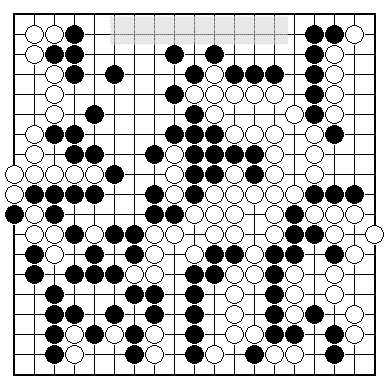

I'm glad to see you once more, my friend, pushing through the door at Dan's burdened by briefcase and fast food detritus. Your first question: "Which one is Dan?"
That's something of a chestnut round here. The regulars at the club amuse themselves by making up disinformative answers ("he joined the Foreign Legion after losing once too often", "he drank so much green tea someone ran a Flymo over him on the beach", "he became a drug dealer because he wanted to meet a better class of person"). Whatever the truth of the matter, the name has stuck. Go in the oriental countries has a system of dan grades for experts, just as the martial arts do.
We admire some games in progress. Here's one in its latter stages - about 200 plays made.

Plenty to look at here. Black seems to have suffered a major disaster in the lower right. However, I want to draw your attention to an uncontested area on the top side (grey shading). This looks likely to become Black's settled territory.
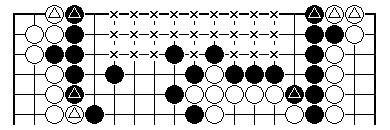
Indeed a few minutes later that part of the board looks this way. Only a few more stones have been added, those with triangle markings. White, relying on experience, has decided not dispute this area by playing inside it. That leaves all the points marked with an 'x', and more, in Black's hands. This has been on the cards from early on in the game.
The intuitive idea of territory is accessible enough. What powers the competitive and strategic side of go is that the long-term safety of groups of stones also depends on territory, in the majority of cases. White's decision in the game can only be explained in those terms. As he puts it when we ask why no invasion here, "it looked like a waste of everyone's time".
To begin to understand that, we have to look at what are called eyes. This is a key concept that arises out of the tactics of capture. An eye is a well-defended liberty of a certain kind. If you have two such eyes, separate but within one formation, you can baffle all attempts to capture it. White reckoned that this couldn't actually be done within the area we were considering, so that Black could deal with invaders by capturing them.
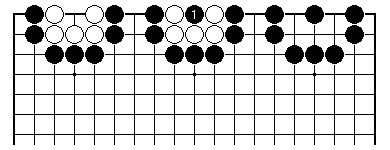
Here White's five-stone chain has a single eye. This is not enough for safety, and Black captures White. But Black 1 is playing into a "captured" position, so there is something special about that particular one of White's liberties. Black can only play there after filling seven other liberties on the outside.
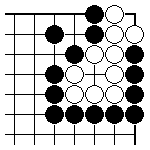
That logic carries over more powerfully to this white corner formation. It is safe from capture. Black cannot play on either of the remaining liberties of the white chain, which are both eyes.
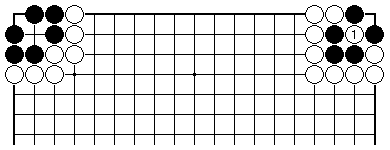
The left-hand corner in this diagram shows a safe two-eyed group also. It is worth commenting that it is made up of two black chains. It would be fatal for Black to join up those two chains by playing on either of the eye points: that would simply allow White to capture the black corner. The careful terminology distinguishing chains from groups, which may contain several chains, pays off here.
That the whole business of eyes is quite subtle is shown by the example in the other corner. White 1 captures three black stones. Therefore the point on which it was played was not an eye for Black - it is what is known in the trade as a false eye.
It is perfectly legal to play inside what appears to be your opponent's area. You must stop short of suicide, though. To add to what I said last time about chains with no liberties, it is illegal to create one in a suicidal way. Chains with no liberties are not allowed, and you are not allowed to play into a "captured" position if you are not thereby making a capture of the opponent's stones. In particular plays into one-point eyes, the sort I've shown you so far, are ruled out, unless they are captures.
You would rarely want to commit suicide anyway, but this takes care of one of two restrictions on play I mentioned before. The other one is to do with repetition of position (the ko rule), and needs a lesson to itself.
Territory may of course be contested, and in numerous ways. One often sees players trying speculative invasions of territory, simple fishing expeditions hoping for a mistake on the part of the opponent. One slip by the defender, and territory, eyes and safety may all be gone. This is a habit to grow out of, though, if you take any pride in your Go ability - eventually it will hold you back.
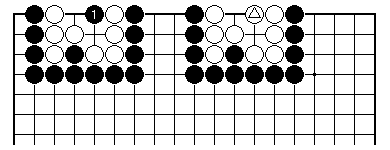
Here is a simple example of quite justified invasion. In this case Black 1 puts White into immediate trouble. It threatens the four-stone chain next to it with instant capture. White can connect up the two chains, but is unable to gain any liberties that way. All White's stones are lost. For the safety of this group White needed one more play, in the position marked with the triangle. Then the group would have been safe from attack.
You hark back to Othello, where the corners are safe. Yes, and some concave triangular formations built on them. The capture rule in Go moves out into two dimensions. It brings with it a vast range of safe formations - recognising these is a study in itself, which players call "life-and-death".
First published 7 February 2000 as On Your Side on MindZine,
Go Learning
© Charles Matthews 2000.